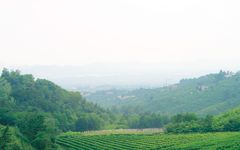La Marca Prosecco Rose 2020
-
James
Suckling



Product Details
Your Rating
Somm Note
Winemaker Notes
Shining from the first toast to the last sip, our playful pop of pink offers an effervescent new way to enjoy Rosé. Offering the bright, crisp fruit and floral essence of our traditional Prosecco with the delicate elegance of Pinot Noir, La Marca Prosecco Rosé D.O.C. sparkles with our classic notes of fresh-picked citrus, honeysuckle, peach and pear, blending with hints of ripe red cherry, raspberry and wild strawberry. Lively and refreshingly zesty, this bubbly is perfect for both playful occasions and spontaneous celebrations.
Blend: 89% Glera, 11% Pinot Noir
Professional Ratings
-
James Suckling
A pale cherry-colored rosé with aromas of raspberries, grapefruit and peach pit. It’s light- to medium-bodied with sleek bubbles and a fresh, fruity palate. Lightly off-dry. Drink now.
Other Vintages
2021-
James
Suckling








Founded more than 40 years ago, La Marca is a cooperative representing 5,000 local wine growers who farm more than 17,000 acres in the Veneto region of northern Italy. La Marca Prosecco elevates the everyday with a crisp, refreshing style and a delicate, floral palate. Made from the expressive Glera grape —found in the hillside vineyards of Italy’s Prosecco capital, Treviso. In 2007, the winery was awarded a “Top 100 Wines of the Year” by Wine Spectator. La Marca is the only Prosecco Producer from the Veneto Region to be awarded this honor.

What are the different types of sparkling rosé wine?
Rosé sparkling wines like Champagne, Prosecco, Cava, and others make a fun and festive alternative to regular bubbles—but don’t snub these as not as important as their clear counterparts. Rosé Champagnes (i.e., those coming from the Champagne region of France) are made in the same basic way as regular Champagne, from the same grapes and the same region. Most other regions where sparkling wine is produced, and where red grape varieties also grow, also make a rosé version.
How is sparkling rosé wine made?
There are two main methods to make rosé sparkling wine. Typically, either white wine is blended with red wine to make a rosé base wine, or only red grapes are used but spend a short period of time on their skins (maceration) to make rosé colored juice before pressing and fermentation. In either case the base wine goes through a second fermentation (the one that makes the bubbles) through any of the various sparkling wine making methods.
What gives rosé Champagne and sparkling wine their color and bubbles?
The bubbles in sparkling wine are formed when the base wine undergoes a secondary fermentation, which traps carbon dioxide inside the bottle or fermentation vessel. During this stage, the yeast cells can absorb some of the wine’s color but for the most part, the pink hue remains.
How do you serve rosé sparkling wine?
Treat rosé sparkling wine as you would treat any Champagne, Prosecco, Cava, and other sparkling wine of comparable quality. For storing in any long-term sense, these should be kept at cellar temperature, about 55F. For serving, cool to about 40F to 50F. As for drinking, the best glasses have a stem and a flute or tulip shape to allow the bead (bubbles) and beautiful rosé hue to show.
How long do rosé Champagne and sparkling wine last?
Most rosé versions of Prosecco, Champagne, Cava or others around the “$20 and under” price point are intended for early consumption. Those made using the traditional method with extended cellar time before release (e.g., Champagne or Crémant) can typically improve with age. If you are unsure, definitely consult a wine professional for guidance.

One of the world’s most popular and playful sparkling wines, Prosecco is a specialty of northeastern Italy, spanning nine provinces of the Veneto and Fruili-Venezia Giulia regions. A higher-quality version of Prosecco wine that must meet more stringent production requirements is known as Prosecco Superiore and must come from the more rugged terrain between the towns of Valdobiaddene and Conegliano. Prosecco can be produced as a still wine, a semi-sparkling wine (“frizzante”), or a fully sparkling wine (“spumante”)—the latter being the most common. While Prosecco wine is typically produced in a “brut” (dry) style, its fresh and fruity character makes it seem a bit sweeter than it actually is. “Extra dry” styles, incorporating higher levels of residual sugar, are quite popular, however.
Prosecco wine is made from the Glera grape, which was formerly and confusingly called Prosecco, these wines are notable for pleasant flavors of peach, pear, melon, green apple, and honeysuckle. Lower pressure during the carbonation process (also called the tank method) means that the bubbles are lighter and frothier than in Champagne or other traditional method sparkling wine, and less persistent. Prosecco is also a great choice to blend with orange juice for mimosas for a classic brunch beverage.
